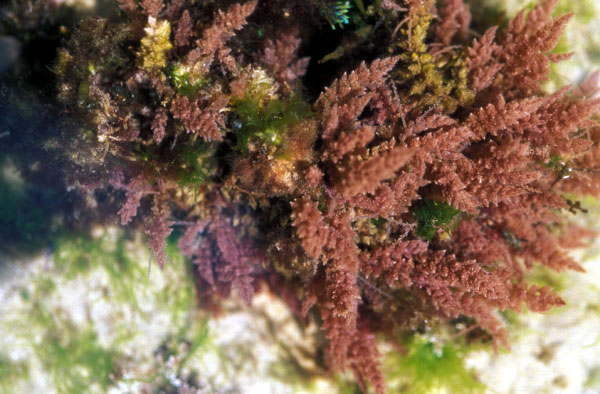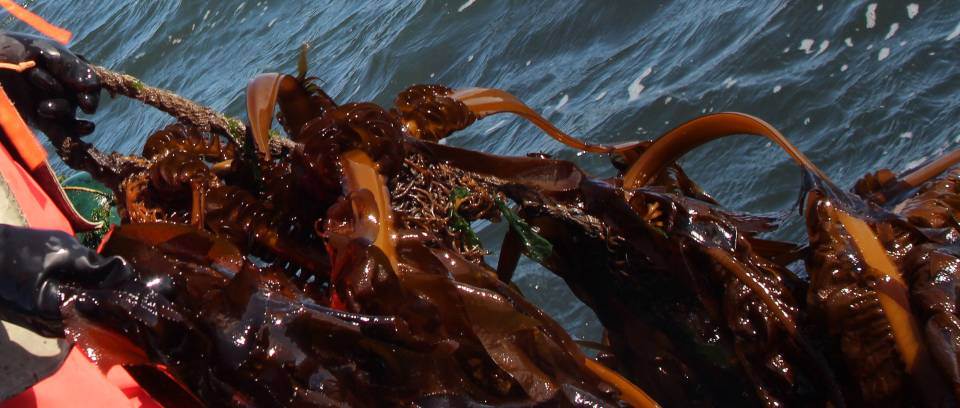Viable protoplasts were isolated from cultured thailus of agar yeilding red seaweed Gracilaria edulis using an enzyme mixture of 3% ONOZUKA R-10 cellulase 3% R-10 macerozyme, 1 % agarase and 1% pectinase in a seaweed protoplast washing medium (SPW) containing seawater and 1 M mannitol. After repeated washing wiih sterile medium, the protoplasts were maintained in light and attempts were made on electrofusion of protoplasts.
Digital library
-
-
Seaweeds, as the name implies covers the macroscopic plant life of the sea except the flowering plants. Most of the seaweeds are attached to rocks and also grow oh other plants as epiphytes. Along the coastline of India, seaweeds are abundant where rocky or coral formations occur. This sort of substratum is found in the states .of Tamil Nadu and Gujsrst and in the vicinity of Bombay, Ratnagiri, Goa, Karwar, Vizhinjam, Varkala, Vishakapatnam and in the Lakshadweep and Andaman-Nicobar Islands. The seaweeds are classified into three important Q'Oups namely Green, Brown and Red seaweeds. Seaweeds contain different vitamins, minerals, trace elements and proteins. Seaweeds are also a rich source of iodine.
-
Slow to find a commercial foothold on the west coast, commercial kelp production is growing rapidly on the Atlantic seaboard where growers in Maine have been cultivating it successfully for several years.
The Hood Canal project funded by a Paul Allen Grant is the first of its kind on the West Coast to investigate the potential of kelp to combat ocean acidification. The first kelp seedlings of a five-year project were unfurled into Puget Sound’s Hood Canal in Washington this spring. The spores, or sori, are raised in tanks at NOAA’s Manchester Research Facility. Scientists from NOAA and the Puget Sound Restoration Fund will monitor the kelp and surrounding waters over time to gauge it’s efficacy at taking up carbon dioxide from the water column.
-
Seaweed cultivation is a growth market worldwide. Seaweed has multiple uses and is a promising resource to contribute to the societal challenges of food security and climate change in the future. However, the mechanisation of seaweed cultivation is essential for further growth, especially in Europe or comparable regions with high labor costs. This development is comparable to the mechanisation of land based agriculture which started with the Industrial Revolution. The seaweed industry will make a similar transition from small scale artisanal cultivation to large scale fully mechansised farming, and we expect this to happen withing the timespan of a few decades. This is going to take place at sea, in the hostile marine environment, and it has to take place in a sustainable way. IHC adressses this formidable challenge from its strenghts and maritime engineering background. Seaweed cultivation mechanisation knowledge is being developed and and combined with our profound understanding of marine engineering. This is necessary in order to realise equipment which fullJls its harvesting functionalities and survive the unforgiving sea environment. IHC MTI, the R&D centre of Royal IHC, has developed a Jrst prototype harvesting machine and tested it to try out and understand harvesting principles and also to demonstrate the potential of mechanised harvesting. The initial prototype realises a cost reduction of 50% and harvesting time reduction of 90%, even at this early stage without impeding sustainability aspects. This presentation exhibits the results of the initial trials with the harvesting prototype. In addition we adress the next steps and technological challenges to achieve mechanised seaweed farming.
-
The physical stresses associated with emersion have long been considered major factors determining the vertical zonation of intertidal seaweeds. We examined Porphyra umbilicalis (Linnaeus) Kützing thalli from the vertical extremes in elevation of an intertidal population ( i.e. upper and lower intertidal zones) to determine whether Porphyra thalli acclimate to different vertical elevations on the shore with different patterns of nitrate uptake and nitrate reductase (NR) and glutamine synthetase (GS) activities in response to different degrees of emersion stress. We found that the nitrate uptake and NR recovery in the emersed tissues took longer in lower intertidal sub-population than in upper intertidal sub-population; and GS activity was also significantly affected by emersion and, interestingly, such an activity was enhanced by emersion of thalli from both upper and lower intertidal zones. These results suggested that intra-population variability in post-emersion recovery of physiological functions such as nutrient uptake and NR activity enables local adaptation and contributes to the wide vertical distribution of P. umbilicalis. The high GS activity during periodic emersion stress may be a protective mechanism enabling P. umbilicalis to assimilate nitrogen quickly when it again becomes available, and may also be an evidence of photorespiration during emersion.
-
The use of microalgae for the production of compounds of commercial relevance has received substantial interest in recent years, mostly because these organisms contain a plethora of valuable compounds and their high turnover rate and functional plasticity make them relatively easy to cultivate for the production of biomass and added-value molecules. The metabolic flexibility of algae allows using them for many commercial applications, but it also makes it easy for cultures to diverge from the intended biomass quality. A thorough comprehension of the principles that control growth and carbon allocation is therefore of paramount importance for effective production of algal biomass and derived chemicals. In this review, we intend to provide basic but exhaustive information on how algae grow and on their biotechnological potential. In addition to this primary goal, we also give the reader a succinct panorama of culturing systems and possible applications.
-
A PDF presentation on "Microalgae Production and Their Use in Animal Feeds".
-
The microbiological conversion of marine plant biomass was studied with stabilized kelp-degrading methane-producing enrichment cultures. Mannitol and alginate are used concurrently. Ethanol is produced shortly after feeding kelp and subsides rapidly. Dissolved hydrogen ranged from 5 nM to 1.2 uM. The appearance of ethanol correlates with increased hydrogen levels which is expected if interspecies hydrogen transfer functions to maintain low concentrations of the more reduced fermentation products. An improved method was developed for measurement of volatile fatty acids in sea water medium based on gas chromatography of the phenyl ester derivatives. Acetate and propionate were found in the greatest concentrations with formate, butyrate and isobutyrate in lower concentrations. The pool sizes will be used with turnover rate constants to determine total flux of each intermediate. A strain of Methanococcus mazei has been isolated that degrades acetate to methane. Also, a highly enriched culture of a previously unreported acetate-degrading methanogen was obtained. New strains of hydrogen and formate-utilizing methanogens were isolated. Mannitol and alginate degrading strains were isolated that resemble Cytophaga sp.
Formate dehydrogenase from Methanobacterium,,formicicum was purified 71-fold and initially characterized. The isolated enzyme contains a cofactor not previously reported in methanogens.
-
The conversion of marine biomass was studied with kelp-degrading methane-producing enrichment cultures. Mannitol and alginate are used concurrently. Hydrogen ranged I from 50nM to 1.2 pM. The appearance of ethanol correlates with increased hydrogen. A method was developed for measurement of intermediates in the sea water medium used for the enrichments. Acetate and propionate were found in the greatest concentrations. Several methylotrophic methanogens were isolated including a new genus, Methanococcoides. New strains of hydrogen and formate-utilizing methanogens were isolated. Formate dehydrogenase from Methanobacterium formicicum was purified and characterized. The isolated enzyme contains a cofactor not previously reported in methanogens. It was shown that formate can be an important substrate for methanogens in anaerobic habitats. For the production of acetate and hydrogen gas in high yield, mannitolfermenting bacteria can be found in strains of Clostridium sphenoides and C. sartagoformum. Alginatefermenting bacteria can be found -ifrainseroidzs ovatus, Cytophaga, Citrobacter and Klebsiella. Hydrogen partial pressure does not affect the fermentation pattern of B. ovatus, but heme does. The low potential electron carrier of - B. ovatus is a ferredoxin.
-
It has been suggested that naturally occurring copper and zinc concentrations in deep seawater are toxic to marine organisms when the free ion forms are overabundant. The effects of micronutrients on the growth of gametophytes of the ecologically and commercially significant giant kelp (Macrocystis pyrifera) were studied in defined media. The results indicate that toxic copper and zinc ion concentrations as well as cobalt and manganese deficiencies may be among the factors controlling the growth of marine organisms in nature.





